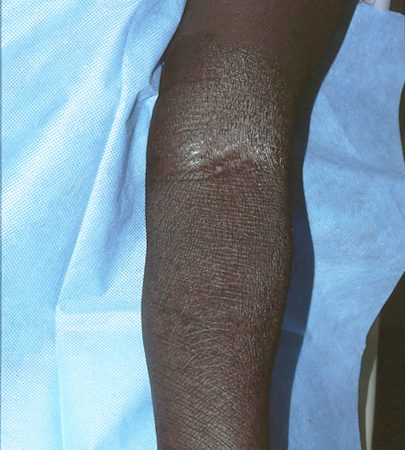Etiology
The etiology of LSC can be categorized into 4 main groups.[2]
Underlying dermatoses: atopic dermatitis, allergic contact dermatitis, stasis dermatitis, superficial fungal (tinea and candidiasis) and dermatophyte infections, lichen sclerosis, viral warts, scabies, lice, arthropod bites, and cutaneous neoplasias.
Systemic conditions causing pruritus: renal failure, obstructive biliary disease (primary biliary cirrhosis and primary sclerosing cholangitis), Hodgkin lymphoma, hyper- or hypothyroidism, and polycythemia rubra vera can all result in secondary LSC.
Environmental factors: heat, sweat, rubbing of clothing, and other irritants such as harsh skin care products.
Psychiatric disorders: anxiety, depression, obsessive-compulsive disorder, and dissociative experiences are often associated with the condition. Emotional tensions in predisposed people (i.e., those with an underlying predisposition for atopic dermatitis, asthma, and allergic rhinitis) can induce itch and thus begin the chronic itch-scratch cycle.[1][2][8][Figure caption and citation for the preceding image starts]: Secondary lichen simplex chronicus in the setting of atopic dermatitisFrom the personal collection of Dr Brian L. Swick; used with permission [Citation ends].
 [Figure caption and citation for the preceding image starts]: Secondary lichen simplex chronicus in the setting of atopic dermatitisFrom the personal collection of Dr Brian L. Swick; used with permission [Citation ends].
[Figure caption and citation for the preceding image starts]: Secondary lichen simplex chronicus in the setting of atopic dermatitisFrom the personal collection of Dr Brian L. Swick; used with permission [Citation ends].
Pathophysiology
LSC results from chronic rubbing and scratching and is characterized by a chronic itch-scratch cycle.[1][2] Cutaneous itch and pain are conveyed to the central nervous system by type C, nonmyelinated sensory nerve fibers. Stimulation of these nerve endings due to disruption of the epidermal barrier or environmental factors leads to the sensation of itch, which can induce a chronic itch-scratch cycle.[2][6]
Dermatoses cause primary or secondary (due to scratching) disruption of the epidermal barrier, and the inherent pruritic nature of many dermatologic diseases can also directly induce a chronic itch-scratch cycle.[2] The role of psychological factors in the pathophysiology of chronic pruritus in LSC has not yet been fully elucidated.[1][2][9][10][11]
Pruritus associated with systemic conditions results from a variety of pathophysiologic mechanisms.
In chronic renal failure, pruritus is multifactorial and related to xerosis, increased serum histamine levels, hypervitaminosis A, elevated parathyroid hormone levels, iron-deficiency anemia, and peripheral neuropathy.[12]
In obstructive biliary disease (primary biliary cirrhosis and primary sclerosing cholangitis) and cirrhosis, pruritus is related to increased opioid levels and downregulation of opioid peptide receptors in the central nervous system and the decreased secretion of bile into the biliary system.[12]
Hyperthyroidism-associated pruritus may result from an increase in activated kinins and vasodilation in the skin as a result of excess thyroid hormone, while pruritus associated with hypothyroidism is most likely due to xerosis.[12]
Hodgkin lymphoma may lead to pruritus as a result of leukopeptidase and bradykinin release as part of an immune response mounted against malignant lymphoid cells.[12]
In polycythemia rubra vera, pruritus is multifactorial and associated with iron-deficiency anemia as well as the combination of mast cell prostaglandins and increased platelet degranulation, which leads to the release of serotonin and prostanoids.[12]
Classification
Etiologic classification[2]
Primary LSC
One or multiple plaques arising de novo on normal-appearing skin in the absence of a primary pruritic cutaneous disorder.[2] The major pruritic triggers are psychological and environmental.[2]
Secondary LSC
One or multiple plaques arising on skin affected by an underlying cutaneous or systemic disorder.[2]
Common primary dermatoses include atopic dermatitis, allergic contact dermatitis, stasis dermatitis, arthropod bites, candidiasis, dermatophyte infections, viral warts, and cutaneous neoplasias.[1][2]
Systemic conditions that can lead to pruritus include renal failure, obstructive biliary disease (primary biliary cirrhosis and primary sclerosing cholangitis), Hodgkin lymphoma, hyper- or hypothyroidism, and polycythemia rubra vera.[1][Figure caption and citation for the preceding image starts]: Secondary lichen simplex chronicus in the setting of atopic dermatitisFrom the personal collection of Dr Brian L. Swick; used with permission [Citation ends].
 [Figure caption and citation for the preceding image starts]: Secondary lichen simplex chronicus in the setting of atopic dermatitisFrom the personal collection of Dr Brian L. Swick; used with permission [Citation ends].
[Figure caption and citation for the preceding image starts]: Secondary lichen simplex chronicus in the setting of atopic dermatitisFrom the personal collection of Dr Brian L. Swick; used with permission [Citation ends].
Use of this content is subject to our disclaimer